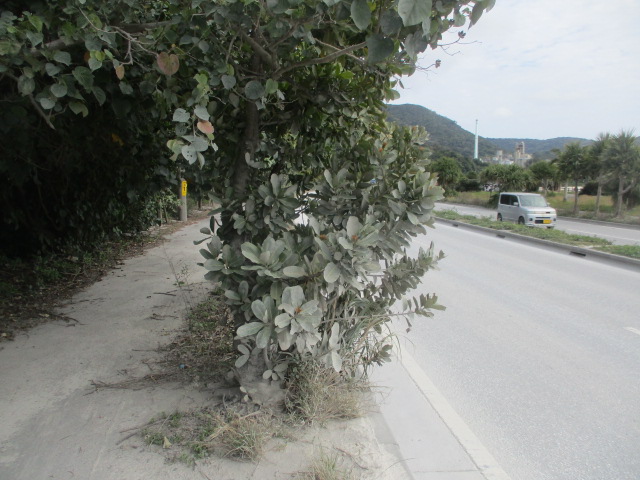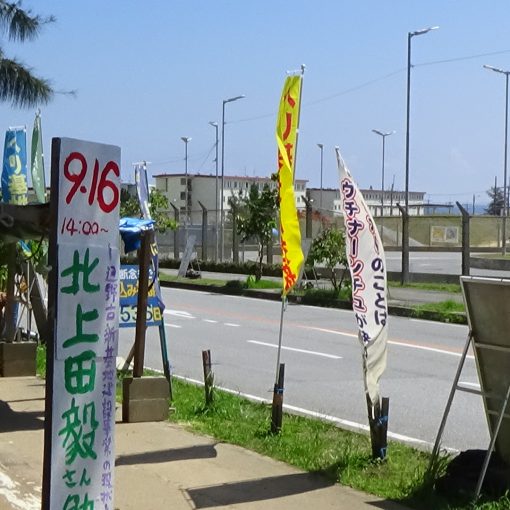Route 449, which is the national road from Awa pier to the port of Shiokawa, is where tourists from abroad travel to visit the popular Churaumi Aquarium. In the summertime, buses and rental cars with tourists from Taiwan, Korea, Europe, and the U.S. continuously come and go. As the road follows the coastline and passes many picturesque sceneries, this road has presented us with Okinawa’s beauty.
Yet, currently, it exposes an abusive situation. The flying white dust from the dump truck loads covers trees and houses. It is too dusty to enjoy walking. Pollution goes further: the truck drivers wash the dump truck tires after making a delivery at the Shiokawa pier, which brings the wash-water with red soil flowing into the ocean. Especially on rainy days, the sea close to the wharf colors red, a practice that goes on for over two years now.
I am concerned with the damages to the Henoko residents. “Washed clothes get immediately dirty again,” “fruits and vegetables are too dusty to sell.” Some residents report health problems, “I have more cough and phlegm recently.”
The new base construction has destroyed the mountains and sea. It is more than obvious how devastating the base construction is to nature and residents when the construction requires a thousand dump trucks driving up and down the road daily. Yet, the plan is that this situation will continue for the next 12 years.
The other day, a group of concerned citizens hand-delivered a petition to the Okinawa Prefectural Assembly to assess the Shiokawa and Awa residents’ damage. The Nago City Assembly will soon discuss the issue. The construction of the U.S. military base is the cause of all these problems and inflicts suffering on us. Japan’s government gets its priorities wrong by placing U.S. military forces over the Japanese citizens in Okinawa.


(In front of Camp Schwab Gate)
It was a day on which the efforts of women played a crucial role. Forty people participated in a sit-in protest, including eight from other prefectures. The women danced and sang some songs, cheering themselves up in front of the gate. During the morning and afternoon, the trucks made 165 deliveries of earth and sand in three rounds.
The pictures taken by a drone on Mar 11 indicate the following: 30% left incomplete on the side of Henoko, area #2, where reclaimed land should be reaching 3 meters above the water’s surface by the end of July. Less than 50% is complete in area #2-1, where the dike should be 8 meters high. We have successfully derailed the initial land reclamation plan in Henoko and hope to delay it further.

(Ryukyu Cement Awa Pier)
Twenty members of the Yanbaru Shimagurumi Kaigi (Yanbaru chapter of Island-Wide Conference) protested at the pier’s entrance and exit. The dump trucks carried in the materials from the quarry over the highway as usual. Aiming to slow down the delivery trucks with the landfill soil even just a bit, protesters cross-walked slowly in front of the gate. The “Henoko Blue” team protested with eight canoes and two rubber boats on the water, which was the first time in 1.5 months. They caused one of the cargo ships delayed for 1.5 hours. Three GoGo Drive Campaign vehicles drove in front of the exit, disabling the dump trucks to depart from the pier.
The workers moved 687 truckloads onto three cargo ships that left for the Oura Bay.

(Motobu Shiokawa Pier)
Five members of Motobu Shimagurumi Kaigi (Motobu chapter of Island-Wide Conference) protested until the end of the day. As there was only a small number of riot police, they could continue with a small number and slow down the dump trucks by crisscrossing over the road. It becomes warmer, and the Morning glory is blooming at the side of the road. However, with the rising temperature and drier air, the trucks lose tons of dust that goes flying around.
The workers moved 706 truckloads of earth and sand onto five cargo ships.


Number of dump trucks to date and percentage against the total
The estimation calculated on the basis of the number of ruckloads serves only as a reference.
Number of dump trucks which made delivery from December 2018 to the end of December 2020 302,705(3.746%)
| 13(Sat) | 15(Mon) | 16(Tue) | 17(Wed) | 18(Thu) | 19(Fri) | |
| Awa | 822(4) | 278(1) | 949(4) | 687(3) | ||
| Shiokawa | 0 | 689(5) | 710(5) | 706(5) |
| Number of dump trucks ※ |
Weightt of earth/sand
※① |
Converted to volume
※② |
Volume per Total
※③ |
| 358,973 | 1,794,865 t | 897,433㎥ | 4.443 % |
※ Cumulative since Dec. 1, 2019
※① Calculated by assuming that the average truckload per dump truck would be 5 tons
※② Calculated by assuming that a specific weight of soil/sand set to be 2
※③ Percentage against 20.200.000m3, the total volume of earth and sand required for the landfill.





